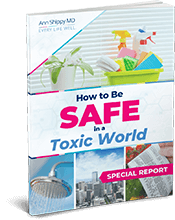Surprising Places You Might Find Mold
Mold is fungi that has been around for millions of years.
Mold spores are everywhere and will always grow where there is moisture. Outdoors it can be more of a nuisance, indoors is where the major health issues can occur.
It is estimated that more than 50% of homes in the US have mold growing in them affecting the air quality. It’s also common in other buildings, such as workplaces and schools, where people spend a significant amount of time.
Some people have traditional allergies or asthma to everyday mold exposures and may experience a runny nose, eye irritation, sneezing, hives and other allergic symptoms. However the issue with mold goes well beyond that.
Specific molds produce toxins that can harm human health. Although it is possible to be exposed to toxic mold and not experience any symptoms, many will suffer from headaches, memory loss, cognitive dysfunction, neurological issues, autoimmunity, fatigue, hair loss, hormone imbalance and others that can become quite severe.
Mold toxicity has even been linked to cancer.
We typically only think of mold in cases of flooding, obvious water leaks or in very humid climates. We also frequently rely on the fact that big mold issues can be seen or smelled, which often they can.
However, it is important to note that mold will grow wherever the conditions are right – poor air circulation plus moisture is prime breeding ground.
And often mold is hidden from view and silently contributes to illness.
If you think that mold is contributing to your symptoms or is a piece of your health puzzle, keep reading to learn about many surprising places that mold can hide.
14 Places To Check For Mold
1. Dishwasher – Inside and around the dishwasher there can be tiny leaks that are often not noticed, but they can create enough moisture for mold to grow. Inside the dishwasher, leftover food particles along with the moist, dark environment make it easy for mold to make a home in there.
Interestingly, many mold spores can survive the hot water cycle and detergents used in a dishwasher.
To prevent mold in the dishwasher, wash it monthly with baking soda and vinegar and check that the parts seal well. You may even want to pull the unit out to check for mold behind it from humidity or a slow leak.
2. Sinks – Sinks in the kitchen and bathroom can have small leaks in the pipes, often in the cabinet below the sink, which might be cluttered or not checked often for leaks. Cooking can lead to high humidity, creating an ideal environment for mold.
Be sure to check under all sinks in the home from time to time for any small leaks, wet surfaces or water damage. It is also helpful to install moisture detectors in areas to detect leaks early. (add link to water sensor)
3. Exhaust vents – Vents, especially from humid areas like the bath and laundry, are another place that you may find mold in your home. Vents may become clogged with dust and debris and remain moist allowing mold to grow. Interestingly, some mold can grow on many materials including plastic and stucco.
4. Wash machine – The laundry room is yet another place to check for mold. Front-loading wash machines are particularly known for harboring mold because they often don’t fully dry out when not in use. Be sure to check the soap dispenser and rubber lining around the door for moisture and mold.
Reduce the risk for mold by opening the soap dispenser and leaving the door open after each load to allow the machine to fully dry.
5. Balconies and roofs – Water leaks can occur anywhere in the home, including outdoor areas like balconies and roofs, can allow water to come into the house. Balconies and flat roofs are especially hard to effectively waterproof. Damp, dark areas under the roofs and balconies can harbor mold, which can spread to other areas of the home.
6. Chimneys – Flashing is often installed to prevent water from entering the home where the roof and chimney meet and sometimes the flashing can fail allowing weather to enter the attic and drip down the walls into a home creating hidden mold.
A chimney and attic inspection, regular cleaning and waterproofing can help to reduce this risk.
7. Refrigerator – Water lines that lead to the ice maker are notorious for leaking. This is also true of ice machines at restaurants that may not regularly be cleaned. In addition, pans inside the fridge collect condensation and even liquids that spill.
Cleaning out your fridge regularly is a great solution. Be sure to check for any standing water often, along with the pans and ice maker. Consider using silicone ice cube trays and use filtered water to make ice cubes.
8. Doors and windows – This is a more obvious place where mold can grow, especially with older windows and doors where seals might be compromised allowing rain from outside to get in. Condensation that often collects on these surfaces can also contribute to mold.
It is important to clean mold as soon as you notice it to prevent mold and mold spores from spreading. It’s important to contact a mold remediation expert to make sure it is done safely.
9. Heating and air conditioning – This includes both separate AC units along with the HVAC (heating, ventilating, air conditioning) systems inside homes. Mold can establish itself in these places and then be dispersed throughout the home.
Even though The Environmental Protection Agency (EPA) recommends hiring a professional to clean air ducts, I have not found that this is effective for most patients. Commonly the AC system and vents need to be replaced when they test positive for mold.
10. Paper and cardboard – If you have damp spaces where there are books, boxes or papers, mold may be growing on these surfaces. If these items are removed for mold remediation and then brought back in the home, they can distribute mold again in the indoor air. The easiest way to get rid of this mold, is often to throw away the items.
11. Fabric, upholstery and carpets – Just like mold can grow on paper, fabric is another area to be aware of. Sometimes fabric, such as clothing, bedding and curtains can be washed using a special mold-killing laundry additive. Most carpet and upholstery need to be replaced. When pets (or kids) have accidents on the carpet or liquids get spilled, be sure to clean up the mess as soon as possible. Set up a fan to help the carpet dry out. Also, frequent vacuuming helps to remove mold spores from the home. If you have wood floors and use rugs, rugs can also be cleaned or vacuumed regularly.
12. Car – Most of us often think about our home as the main place to check for mold, especially if we are having symptoms. However, work places, libraries, schools, churches and other places where we spend a lot of time, including the car, can contribute. Yes, mold can grow in your car. Wet shoes, spills or leaks can bring moisture into the car and mold can grow, often undetected. The air conditioning systems in cars are also notorious for becoming moldy.
13. Wallpaper – Mold can grow behind wallpaper, especially if it is in a moist area like a bathroom or basement. Removing wallpaper from any rooms with a high humidity can be a good strategy as you might not be able to visibly see the first signs of mold.
14. Attic – Attics are known for poor air circulation, darkness and lots of dust. Any moisture from a leak or condensation can create the conditions for mold to thrive and spread. Mold can grow on wood, insulation and other attic materials.
I recommend keeping your attic clean and inspecting for leaks regularly. Be sure to check for leaks in the windows, roof, pipes and HVAC systems.
It’s a myth that mold only grows in humid climates, buildings in dry areas are just as much at risk because water leaks, condensation and moisture can occur in many places throughout the home. And mold is everywhere, just looking for a place to land and thrive.
To be proactive about mold and reduce your toxic exposures, have regular home inspections and encourage workplaces to do the same. You can also install moisture detectors to alert you of a possible problem before it becomes a huge issue..
If you suspect mold in your environment, hire an expert in mold inspection to evaluate it for you and a remediation expert to help create a safe living environment moving forward. Cleaning up the mold that is making you sick is root cause medicine at its best.
If you are interested in learning more about ways to support and nourish your body after a mold exposure, this article covers conditions caused by mold and simple strategies to implement and this article goes into detail about how to support the detoxification pathways of the body.
Nutrition, detoxification strategies and supplements can help immensely to relieve symptoms and aid in recovery.
Download my “Could It Be Mold?” fact sheet for notes, facts, tips, and resources to help you determine if you have mold. These resources are also helpful for taking preventative action steps to avoid any future mold problems.
Living in a healthy, low-toxin living environment is foundational for well-being and living your best life!













